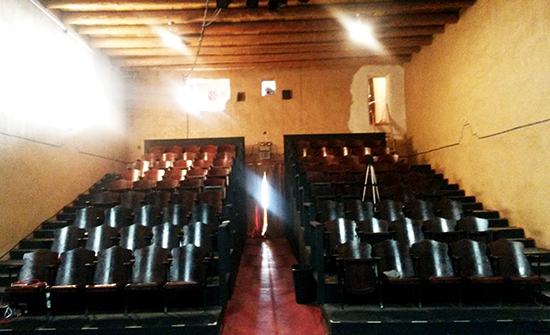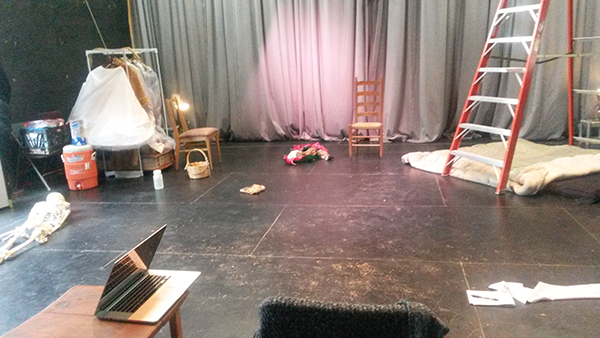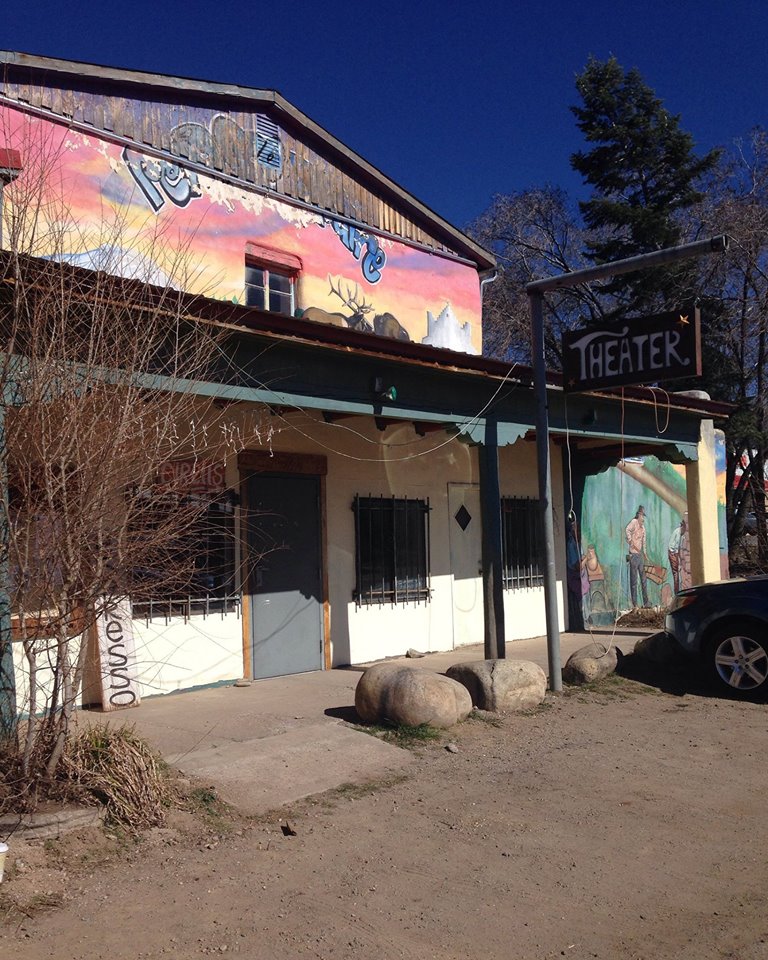Building an Artistic Community in Small-Town New Mexico
An Interview with Alessandra Ogren and Rebekah Tarín
BY EMMALY WIEDERHOLT
Alessandra Ogren and Rebekah Tarín are members of the collective that run the Peñasco Theatre. Located in Peñasco, New Mexico—a town of about 1,200 residents—the theater hosts classes, workshops, performances and residencies, creating a vibrant arts community where one might not expect to look.
This interview is part of Where Dance Is, a series of interviews with artists working in rural places.
~~
How did you come to live and work in Peñsasco?
Alessandra: I found the theater 16 and a half years ago. I didn’t have any intention of buying property and moving here. I had friends who lived up here and talked me into looking at the theater. They ended up moving away, and I bought the theater. The theater was built in 1940 by Amado and Josephine Roybal. It seems like it was the center of the community in the ‘40s and ‘50s. Older people still tell me, “I used to come here every weekend.”
Rebekah: I came in 2003 to teach. I worked for Wise Fool and taught in the summer program for many years in a row. I was living in Taos, and after our son was born it seemed to make sense instead of going back and forth.
What is your current artistic practice?
Rebekah: We’re parents, so that’s changed how we go about doing our own work. We’re committed to bringing the art forms both of us do, as well as the art forms other people do, into the community and trying to make them available for young people. That’s our primary focus. The programming we have and how our practice relates to it focuses on way in which we can improve what we do so we can offer more.
Rebekah: It’s hard to juggle family life, work and the space (which is old and requires a lot of maintenance). That’s all part of it. Alessandra and I trade off a lot and try to give each other space to do our work. We travel a lot too in order to get inspired, see other artists’ work, attend workshops, etc.
For what we have here, who we are, and our limited resources, we make a really good go of trying to stay up on what’s happening in our respective fields. I feel we also contribute greatly to the overall dialogue on youth and social justice arts.
It’s easy to fall into certain kinds of traps around money and hierarchy, as well as certain aesthetics, and we’re trying to offer opportunities for artists who operate outside those spaces. If you have those frameworks, then you have access. If you don’t, then you essentially don’t have access. As a queer person of color, my practice relates because I don’t fit in those models, and I’m not interested in fitting in those models. I think our space is an avenue to provide that.
Alessandra: Years ago, I had an aerial teacher say that at some point I’d have to choose between being a teacher and performer. It’s challenging to do both. I didn’t really listen, but it’s true. My focus was on creating my own work and performing, and I was traveling a lot. Because my schedule was so sporadic, it was hard to get a class going. Since having kids, my focus has shifted toward being a teacher and the consistency that’s required. To really commit to teaching, you can’t leave all the time. That’s a tricky balance and, even still, I have to find ways to keep challenging my students as they get better and better. I don’t want to get stuck teaching the same thing over and over.
I’ve had students who have gone on to perform, but I ask myself what we’re really trying to instill in the young people we reach. How are these technical skills in circus or art ways to teach other important life skills? Trying to grow that part of our work is important.
How do you financially fund the space?
Alessandra: Our youth programs are dependent on grant funding. The space itself has no funding except what we personally pour into it. That would be something I’d like to change, but there’s not a lot of funding opportunities for maintaining a space. There are some grants we’ve looked at for residencies, but right now the space and residency programs aren’t funded at all.
What are some of the benefits and drawbacks to being in a more rural location?
Alessandra: What this space is really good for is having no distractions. There’s also something about this space… I really believe in the physicality of the theater; it’s a rich creative environment. There’s something about it that incubates and feeds creative thought and movement. It has a special energy beyond its isolation.
The challenge is that it’s hard to go anywhere. You’re looking at least at an hour travel time. But then, if you think about it, that’s how much time it takes to travel across the Bay Area, New York or Los Angeles. And in those places, there’s so much external stimulus. Sometimes I have to remind myself of that.
Rebekah: I like quiet and privacy. I do collaborative work, but I also like working by myself. I like to go into my studio for several hours without interruption. However, we’re in the middle of town and run this business, so there’s not that sometimes. I’ve lived even more remotely than this, and I really liked that. Moving to Peñasco was moving to “town” for me, so it’s interesting how your perspective can shift.
Another drawback for me is that there aren’t a lot of queer folks here. In terms of our family, the town is a little conservative. That can be hard. Having kids really helped us integrate more because now we’re seen as regular people, because they know what that feels like. That’s afforded us a lot more access. People feel more comfortable coming to the space.
A benefit of being here is we live very cheaply. That allows us to work project to project, and then have breaks that allow us to be with our kids, as well as do our own work. When we think about going other places, we realize we wouldn’t be able to afford our present lifestyle. Even in Santa Fe or Taos you can’t live as cheaply as we do. I feel super grateful we can do what we want to do.
What do you perceive has been your influence on Peñasco’s community?
Alessandra: Peñasco has many communities within it, and our work has definitely impacted the communities we reach. Young people who grew up in this area started taking trapeze when they were three, and ended up going to the New Mexico School for the Arts. It’s inspiring having been somewhere long enough that you can see that result. Before moving here, I would teach at lots of projects, but to have been somewhere and seen a generation grow up is pretty significant.
With the greater Peñasco community, it’s hard to know. Sometimes someone new will come to class who lives close by, and will say, “I never knew there were classes here.” Sixteen years later this still happens.
It’s the whole spectrum, from people whose lives have been completely transformed, to people who don’t even know we’re here.
Rebekah: We’ve also had a lot of people come from different places, and they bring their art forms and perspectives that people in this community would otherwise never experience. We’ve had over 290 residencies since 2009, from all over the world.
Peñasco is a hard place because there’s a lot going on you can’t see. There’s a lot of addiction and economic struggle. People don’t always access the resources that are in front of them because they don’t internally have the capacity to do so. There’s a lot of historical trauma.
You can’t always quantify the benefits. Sometimes a kid comes the first day and won’t leave their parent, and by the end they’re standing proudly in front singing their song. That’s a huge internal process that’s unexplainable unless you see it. It’s about changing a value system.
Right now in our country, the human life has such little value. Through our programs, we’re saying: You’re beautiful, what you have inside you is beautiful, what you have to say is beautiful. If you think something is beautiful, you won’t destroy it. This is what we believe; the kids, the parents, the things people bring… they all have value.
~~
To learn more about Peñasco Theatre and the collective that runs it, visit here.
ALESSANDRA OGREN is a director, choreographer, accomplished aerialist, visual artist, lightning designer, actress, dancer and teacher with extensive experience in many aspects of the performing arts. She is a co-founder and former co-artistic director of Wise Fool New Mexico, a community-based performance company incorporating circus arts into visual theatre. She teaches circus arts in the U.S. and internationally.
REBEKAH TARÍN is a self-taught visual artist, educator and critical thinker working with The Peñasco Theatre Collective since 2003. She brings the disciplines of puppetry, stilt-walking, mask-making and visual art to communities of school children all over Northern New Mexico. Rebekah coordinates many aspects of the youth programming. Her artwork can be viewed at www.brushfireartemasfina.com and www.artbeatconversations.com.



